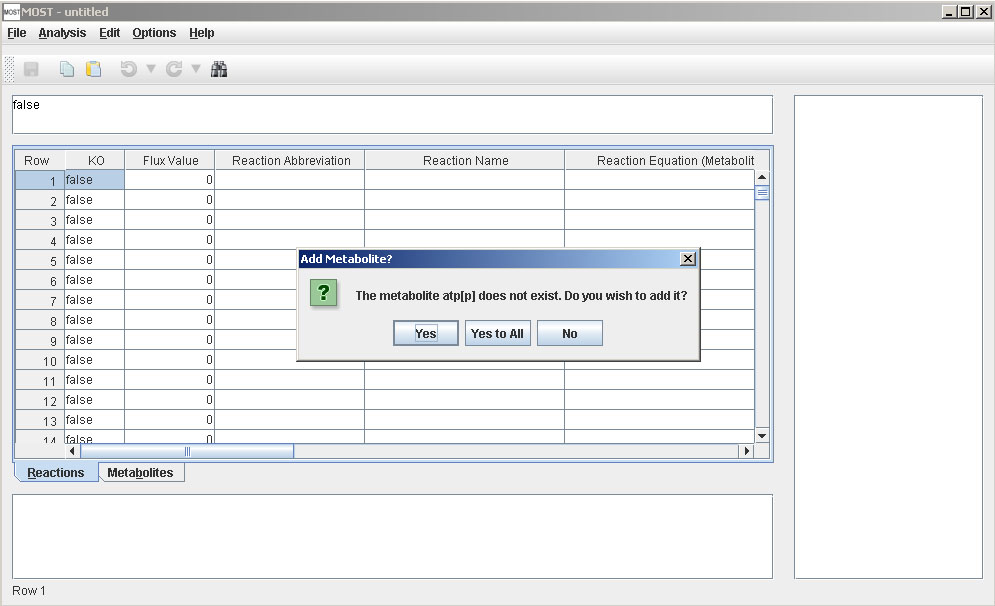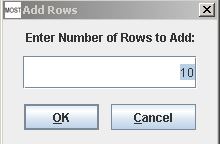Help Topics
- Load SBML
- Load CSV
- Load Excel Spreadsheets
- Load from Model Collection
- Saving Files
- Clear Tables
- Exit
- Visualize Compartment
- Show Visualization Report
- Locate Identifier Columns
- Set Edge Flux Levels
- Reset Edge Flux Levels to Default
- Visualization Frame Menus
Edit Menu
Edit Menu
Note: Results of Analyses are not editable. After running an Analysis, the result will be selected in the tree (panel on right side of MOST). When a result is selected, any menu item that could be used to change the results will be grayed out. This includes most of the menu items in the Edit menu and Context menus.
If the Metabolites table contains metabolite abbreviations that do not participate in any reaction, MOST makes it easy to find these metabolites and delete them. The following two menu items can be used for this purpose:
Highlight Unused Metabolites:
Select Edit -> Highlight Unused Metabolites (Alt+E then Alt+H)
MOST will automatically tab to the Metabolites table if not already there. If the check box next to the menu item is checked, unused metabolites will be highlighted yellow. If un-checked, there will be no highlighting.
Delete All Unused Metabolites:
Select Edit -> Delete All Unused Metabolites (Alt+E then Alt+D)
If the loaded model does not contain any unused metabolites, these menu items will be grayed out.
MOST uses the arrow in a reaction to split the reaction into reactants and products strings of the reaction, then “ + “ (space plus space) to split the reactants and products strings into individual species. If a reaction contains a “+” without a space preceding and following it, the result is a species that contains a “+” which is flagged as suspicious. (Species that end with a “+” such as H+ are not flagged and are perfectly acceptable). So a reaction A +B + C D+ E will result in two suspicious metabolites: “A +B” and “D+ E”. If there are any suspicious metabolites in the loaded model, the message “Model contains suspicious metabolites” will appear in the Status Bar. These metabolites will be highlighted red. MOST makes it easy to locate these suspicious metabolites in the Metabolites table by using the “Find Suspicious Metabolites” menu item.
Find Suspicious Metabolites:
Select Edit -> Find Suspicious Metabolites (Alt+E then Alt+ S)
MOST will automatically tab to the Metabolites table if not already there, and the first suspicious metabolite will be selected.
In order to locate the reaction or reactions that contain the suspicious metabolite (and therefore are improperly spaced), right-click on the cell containing the suspicious metabolite, and click “Highlight Participating Reactions”. All reactions that contain it will be highlighted green. Each reaction can be edited to correct the spacing, or Find/Replace can be used to correct the reactions, (e.g. – for “A +B”):
Type A +B in the Find field and A + B in the Replace field, and click the “Replace All” button). If there are any reactions that have metabolites/compounds that are not present in the Metabolites table, the Add Metabolite prompt will appear:

Click “Yes” to add the metabolite, “Yes to All” to suppress the prompt for remaining metabolites in the reaction, or “No” to not add the metabolite. If “No” is pressed, the metabolite will also be removed from the reaction. When all of the reactions that contain the suspicious metabolite have been corrected, the suspicious metabolite will be able to be deleted. (Metabolites that participate in reactions cannot be deleted.) After all reactions that contain suspicious metabolites have been corrected, the “Model contains suspicious metabolites” message in the Status Bar will disappear.
See Reaction Editor in Context Menu tutorial. Using the Reaction Editor will make editing reaction easier and the resulting reactions will always be spaced correctly.
Undo:
Select Edit -> Undo (Clrl+Z) or use the Undo button (counterclockwise arrow) in the Toolbar.
This will undo the last edit.
Redo:
Select Edit -> Redo (Clrl+Y) or use the Redo button (clockwise arrow) in the Toolbar.
This will redo the last undo action.
If you use the arrows next to the Undo or Redo buttons, a list will appear of all available undo-able or redo-able actions. Any action selected will undo or redo all actions above and including the selected action.
Note that any edits clear the list of redo actions available.
Toolbar with Save, Copy, Paste, Undo, Redo, and Find buttons.

If there are no undoable actions, the Undo and Redo buttons will be grayed out.

Select Edit -> Find/Replace (Alt+ E then Alt+ F or Clrl+F) or use the Find Button (binoculars)
The Find/Replace dialog will appear.

The buttons, check boxes and text fields on the Find/Replace dialog can all be accessed using keyboard shortcuts by using Alt+ and underlined letter.
Example: Find What (Alt+ F)
Replace and Replace All buttons will be disabled when optimization results tables are selected.
Select Edit -> Select All (Alt+ E then Alt+ A or Clrl+A)
All cells will be selected in the table that is currently selected. All cells in the other table will be deselected. If Column names are to be included in the selection, use the Select All in the context menu, and select the radio button for “Include Column Names”
Select Edit -> Add Row to Reactions Table (Alt+E then Alt+R) to add a row to the Reactions table.
Select Edit -> Add Rows to Reactions Table (Alt+E then Alt+W) to add multiple rows to the Reactions table. The add rows dialog will appear.

Select Edit -> Add Row to Metabolites table (Alt+E then Alt+M) to add a row to the Metabolites table.
Select Edit -> Add Rows to Metabolites table (Alt+E then Alt+T) to add multiple rows to the Metabolites table. The add rows dialog will appear.

Select Edit -> Add Row to Compartments table (Alt+E then Alt+P) to add a row to the Compartments table.
Select Edit -> Add Column to Reactions Table (Alt+E then Alt+C) to add a column to the Reactions table. If the column name already exists, an error message will appear.
Select Edit -> Add Column to Metabolites table (Alt+E then Alt+O) to add a column to the Metabolites table. If the column name already exists, an error message will appear.
Tables can be sorted by clicking on the table header of the column to be sorted.
Unsort restores the table to the original load order or order when the file was last saved. Unsort can be very useful in that editing and pasting into sorted columns can result in unexpected behaviors since the column sorts itself when the new data is added. Unsort provides a way of avoiding this behavior.
Select Edit -> Unsort Reactions Table (Alt+E then Alt+T) to unsort the Reactions table.
Select Edit -> Unsort Metabolites Table (Alt+E then Alt+B) to unsort the Metabolites table.